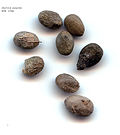Salvia azurea
| Salvia azurea | |
|---|---|

| |
| Scientific classification | |
| Kingdom: | Plantae |
| Clade: | Tracheophytes |
| Clade: | Angiosperms |
| Clade: | Eudicots |
| Clade: | Asterids |
| Order: | Lamiales |
| Family: | Lamiaceae |
| Genus: | Salvia |
| Species: | S. azurea
|
| Binomial name | |
| Salvia azurea | |
Salvia azurea, the azure blue sage,[1] azure sage, blue sage or prairie sage, is a herbaceous perennial in the genus Salvia that is native to Central and Eastern North America.[2][3]
Description

Its thin, upright stems can grow to 6 feet (1.8 m) tall, with narrow, pointed, smooth-edged to serrated, furry to smooth green leaves, connected to their stems by petioles to 0.4 inches (1.0 cm) long. There are no basal leaves.[4]
The blue flowers (rarely white), nearly 1⁄4 to 1⁄2 inch (6.4 to 12.7 mm) long, appear summer to autumn near the ends of their branched or unbranched spikes; their calyxes are tubular or bell-shaped and furry. Two varieties are Salvia azurea var. azurea (azure sage) and Salvia azurea var. grandiflora (pitcher sage).[2][3] It is found on the wild on roadsides, glades, fields and pastures.[4]
References
- ^ USDA, NRCS (n.d.). "Salvia azurea". The PLANTS Database (plants.usda.gov). Greensboro, North Carolina: National Plant Data Team. Retrieved 28 October 2015.
- ^ a b Kathleen N. Brenzel, Editor, Sunset Western Garden Book (Menlo Park, CA: Sunset Publishing Corporation, 2001; ISBN 0-376-03875-6)
- ^ a b Mark Griffiths, Index of Garden Plants, 2nd American Edition. (Portland, Oregon: Timber Press, 1995; ISBN 0-88192-246-3)
- ^ a b Carl G. Hunter, Wild Flowers of Arkansas. 6th edition, p. 192. (Little Rock, Arkansas: The Ozark Society Foundation, 2001; ISBN 0-912456-16-7)
External links
